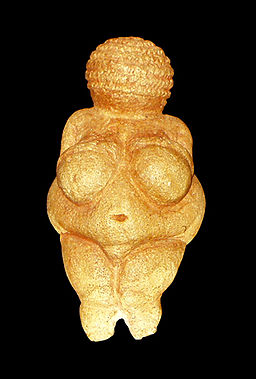
Hohlenstein-stadel – The cave in which the Lion Man figurine was found.
The Lion Man, The First Artist, and The Great Lady
(A Story)
c. 35ka to c.40ka.
He loved crafting things. As a child he would take a piece of wood and use a knife to carve it into people and animals and his mother would store them in her sack. She never threw anything away, which in a way, was a good thing, because as he became better, he saw her trading his sculptures for meat and sometimes even for sewing needles.
As he grew up, he realized that he was different from other boys his age. While they were boisterous and loved to go mammoth hunting, he liked to stray and watch. He would climb a tree and watch the action – and then he would carry a picture of it in his mind. He would draw it on the ground for the women who stayed at the cave and waited for the men to return with their prize.
So when the Great Lady came to him and told him that he would be excused from hunting so that he could sculpt the Lion-man, he couldn’t believe his luck. The offer was unprecedented in the history of his tribe.
“What about the bones and tusks, and the tools that I would need,” he had asked.
“You will get the material,” she had replied, “you can design your tools yourself.”
And so he had sat outside the entrance to their cave where the women cooked and talked and laughed – and under the Juniper tree, he set out his tools. His precious carving tools included a flint chisel, a burin, a piece of mammoth skin, a few stones to soften the hard edges that the burin and the chisel would leave behind.
It was a tough job and the women were amused. They didn’t think that such a big carving was possible.
“Will its head look really look like a lion’s?” one of the women asked.
He was wary about it too. He hadn’t seen it up close. All he remembered was the general shape – and he hoped that he would be able to reproduce it.
“I think it will,” he replied.
“The Great Lady will like it, I am sure,” his mother grinned at the tusk that he had soaked in water for softening. She still had her front teeth and her smile. He smiled back, then took out the tusk from the puddle and started work.
–0–
He kept a count of how many times the Sun had gone down since he had begun work by accumulating the seeds of the juniper tree in the corner of the room where he kept his tools for they were precious and used for creating the divine sculpture. The chamber was lit only by fire that the Great Lady carried in a bowl, and nobody went inside, except to look at the divine fire and be blessed.
Today, after ten fists full of Juniper seeds, the precious statue was finally done. It stood shining under the morning Sun mesmerizing everyone who looked at it. “The head of the statue,” confirmed the hunt-leader, “looked exactly like the head of a lion.”
They marveled at how he who had never fought a lion could bring about such likeness and how he could make the head look like it belonged to the statue. They looked at it with awe.
Then the Great Lady came out, leaning on a stick. She came right to the place where the statue was and bend a little to pick it up. She examined it by turning it left and right, and when she was satisfied, she looked at him with a benign smile.

The Löwenmensch figure or the Lion Man – Material: Mammoth Ivory.
“This Lion-man will now be the source of our power. It shall now forever reside within the fire-room.”
The men and women jumped up and down and swung sideways to share their happiness and celebrate the momentous occasion. Then they all followed the Great Lady inside the cave.
He sat under the juniper tree, feeling oddly strange and empty. He had lived with that statue for such a long time, and now it had been taken away from him. He was glad that he would see it everyday, but now he would never get to touch it or caress it, or add another detail to it. It was no longer his.
He didn’t know that 35k years later, his creation shall be called the first known piece of art and become the origin for the art history of the world.
But he was an artist, and he didn’t care.
Here are the previous two chapters of this book:







